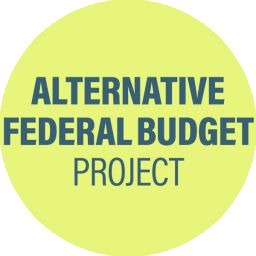Overview
Canada’s economy is full of mixed signals and the recovery is very uneven. Inflation has come down but food prices have continued to climb to their highest rates in four decades.1 Unemployment is at record lows while wages still lag inflation.2,3 The lowest 20 per cent of income earners have seen the highest relative wage gains over pre-pandemic levels but poverty has dramatically worsened.4,5
This uncertainty is compounded by the ongoing climate crisis. Fairer taxation can support public investment toward a post-carbon economy while also reducing poverty and helping provide more robust public services. Further, fiscal policies—both spending and taxation—would have been better suited to reducing inflation in a just manner rather than the reflexive and ill- advised rate hikes from the Bank of Canada.
During the pandemic, the federal government spent record amounts supporting Canadians through the financial upheaval. Pandemic-induced economic instability allowed corporations with pricing power to hike profit margins and claim an outsized share of those financial resources.6 The predictable result was record corporate profits.7,8 The AFB would implement tax measures to reduce extreme wealth concentration, reduce tax dodging, improve corporate accountability, strengthen climate action, support housing for all, and help make life more affordable.
Reduce extreme wealth concentration
In 2021, as more than half a million Canadians slipped below the poverty line, Canada’s 50 richest families added over $30 billion to their wealth.9 That year, Canadian corporations paid out a record $269 billion in dividends, which overwhelmingly go to the wealthiest families.10,11 The ultra-wealthy leverage their assets to wield an undemocratic amount of political, cultural, and economic influence. The right tax measures will help to put that money back into public hands where it can benefit everyone.
Eliminate loopholes
Large corporations and wealthy individuals can use aggressive tax planning to avoid paying taxes. This planning operates at the boundary of tax laws. A lack of penalties for illegitimate use of tax mechanisms means those who can afford expensive accountants and lawyers have an incentive to bend the law as far as it will go and test what tax planning the CRA will ignore. Fortunately, the government is finally moving forward with a promised update to the General Anti-Avoidance Rule, better known as GAAR, which is intended to catch illegitimate uses of tax mechanisms. However, the government also provides some loopholes that ought to be eliminated since they deprive the public of tax revenue without providing any clear public benefit. Despite reaping record profits in recent years, the exploitation of loopholes has pushed the effective corporate tax rate to a record low.12,13 These loopholes cost the public money and worsen inequality. They also create a complex and onerous review process for the CRA, which can make it more difficult to separate legitimate from illegitimate tax planning.
Support climate action
The Canadian government is using the tax system to deliver a lot of its effort on climate adaptation and mitigation. Most obvious is the carbon tax, which is the focal point of the federal government’s climate plan.
However, the 2022 and 2023 federal budgets included tens of billions in tax credits as incentives for corporate investment in emissions-reducing technologies. While there is a role for tax credits as part of Canada’s effort to achieve a net zero economy, the over-emphasis on this specific tool, rather than direct public investment in a just transition, is worrisome (see the Environment and Climate Change chapter).
Invest in transparency and compliance
The current government has failed to meaningfully increase the CRA’s funding, despite promises to do so.14 The public loses tens of billions every year due to non-compliance.15 But even these huge losses pale in comparison to the legally sanctioned avoidance that is facilitated by a lack of transparency and the failure to update our tax laws.16 We need to invest in the CRA to develop the tools and skills to deal with tax avoidance, as well as the task of assessing eligibility for tax credits being offered as part of Canada’s climate response.
Make life more affordable
In 2022, Canadians experienced the highest inflation in a generation. While the rate of inflation has come down significantly, price levels are likely to remain elevated. Investment in greater public services, such as housing or universal pharmacare, would help reduce the growing affordability crisis. Tax measures can support these investments and help reduce inflationary pressures.
Support housing for all
Home ownership is becoming a wedge that divides those who can benefit from rising home prices and those who suffer from an out-of- reach housing market. The federal government is doing too little to make housing—whether home ownership or rental units—affordable for all. In fact, some of what it is doing makes the problem worse.
Actions
The AFB will tax extreme wealth. An annual wealth tax would help to reduce the excessive power of the wealthy. It would also generate an incredible amount of revenue for the public. A progressive tax beginning on net worth over $10 million would bring in $32 billion in the first year, and $409 billion over 10 years.17 In other words, this tax, which could be paid by fewer than 0.5 per cent of Canada’s richest families, would increase federal tax revenue by almost 10 per cent.
The AFB will restore the corporate income tax rate. Canadian governments have cut corporate income tax rates for decades. The reasoning has always been that this will lead to more investment, more innovation, and more jobs. The cuts have cost hundreds of billions of dollars without delivering the supposed benefits.18 Boosting the federal rate to 20 per cent, from its present rate of 15 per cent, which is still low by historical standards, would generate more than $11 billion annually.19
The AFB will implement a minimum tax on book profits. Book profits are what corporations report to their shareholders. They differ from the profits that corporations declare to tax authorities. Corporations are able to use a wide range of strategies to avoid paying billions of dollars in taxes.20 Those strategies include aggressive tax planning that exploits tax laws in unintended ways. A minimum tax on book profits puts a floor on corporate tax avoidance, which is one of the reasons the United States included such a tax in the Inflation Reduction Act (IRA). A minimum tax on 2022 book profits for companies with pre-tax book profits greater than $1 billion—the same threshold as the IRA—would bring in almost $7 billion in revenue.21
The AFB will implement a minimum tax on foreign profits. The OECD plan to address tax avoidance by transnational corporations is inadequate to address the problem.22 Canada should implement a minimum tax of 25 per cent on foreign profits to make up for the shortcomings of the OECD plan. Such a tax could generate $20 billion or more.23
The AFB will raise the inclusion rate for capital gains. Every dollar of workers’ pay gets taxed but only half of capital gains—the income from buying and selling financial assets— gets taxed. Over half of this income goes to the richest one per cent.24 The preferential treatment of financial activity widens the wealth gap and costs the federal government over $20 billion annually.25 The Parliamentary Budget Officer (PBO) estimates that raising the inclusion rate to 75 per cent would bring in more than $9.5 billion.26
The AFB will cap corporate pay deductions at $1 million in total compensation for every employee. Corporate executive salaries hit a new record in 2021.27 This followed a year when corporate boards rigged pay rules to ensure executives would receive bonuses.28 Unlike the United States, which caps executive pay deduction at $1 million, Canadian corporations can claim the full amount of executive pay as an operating expense. Canada should impose a cap, just like the U.S.
The AFB will limit the dividend tax credit, which was intended to compensate shareholders for the income tax that corporations pay. However, because corporations are increasingly avoiding their tax responsibilities, the credit is misapplied. Further, half of benefits go to the top one per cent.29 Limiting this to the tax actually paid would save the federal government at least $1 billion annually; eliminating it entirely would save over $6 billion.30
The AFB will limit loss carry-overs to their level from 2006 of 10 years. When a corporation records a loss it can carry that loss backward or forward to reduce its taxes in profitable years. They applies to both capital and non-capital losses. This costs the government about $11 billion per year. There is no annual limit to the application of these loss carryovers. That means a corporation can eliminate 100 per cent of their taxes in a given year using offsetting losses from a decade ago or more. The AFB will limit the carry-forward period to 10 years for corporate non-capital losses as it existed prior to 2006. It also will allow corporate capital losses to be carried forward only 10 years not indefinitely.
The AFB will end tax agreements with known tax havens to disrupt the international tax avoidance schemes that cost the Canadian public billions of dollars.31 Canada has numerous tax agreements with countries that are known to facilitate tax avoidance. These agreements primarily benefit large corporations and wealthy elites that are able to exploit the low tax rates and extreme secrecy provided by these jurisdictions.
The AFB will provide the CRA with the resources required to monitor and regulate the charitable sector in a way that ensures tax-exempted dollars benefit the public, while protecting against possible individual harms and damaging labor force implications resulting from recent regulatory changes. The changes introduced in the 2022 federal budget that allow charities, including foundations, to provide grants to non- charities have seen a slow path to implementation, with the CRA yet to release their final policy guidelines on the subject. This new regulatory regime provides access to philanthropic dollars for grassroots groups that had previously been structurally excluded from the sector—an important move, especially for under-resourced groups that might lack the finances or professional connections to navigate the cumbersome process of applying for charitable status. However, some of the broader implications of these changes require closer monitoring. Content in the newly revised CRA Charities Directorate’s T3010 Form points to some troubling possibilities, as it makes clear the ability for charities to provide funding to for-profits to deliver education and health care programs.
Other jurisdictions with similar regulatory allowances show a common practice of large, for-profit corporations receiving tax-exempted dollars. From a labour standpoint, in a sector that already has an employment precarity issue, the tax implications for individuals receiving gifts, and how the new legislation interacts with employment status, are areas of concern. Although these regulatory changes have been described as the most significant the charitable sector has seen in decades, the CRA does not appear to have the requisite resources to monitor unintended harms. Additional CRA staff to first provide proactive support to charities and would-be grantees to help them navigate these new regulations, reducing the possibilities of abuse or unintended harms, is a critical investment.
The CRA also requires specific capacity to analyze the impacts of this regime in relation to employment, taxation, and privatization. The AFB will provide $25 million a year to help charities in that regard.
The AFB will implement a border carbon tariff and tax all carbon emissions. Currently, the emissions from the oil and gas sector are not subject to the carbon tax, despite producing 26 per cent of Canada’s emissions. This exclusion was intended to keep Canadian oil and gas internationally competitive. However, it has undermined the country’s ability to meet its emission reduction goals. Carbon pricing should be applied to all emissions from large emitters, combined with carbon tariffs on imports from countries not pricing emissions and rebates on Canadian exports to those countries. This would make Canadian industry more competitive and increase the federal government’s revenues by approximately $3 billion annually.
The AFB will strengthen labour and accountability rules for climate tax credits. Some of the climate tax credits being offered to corporations include an incentive to meet labour standards. Companies that meet the standards are able to claim a higher credit. However, this incentive should be turned into a requirement to prevent some companies from choosing to sacrifice a portion of the credit so they can pay lower wages. The government also needs to expand the jobs covered by the labour requirement. Additionally, in order to ensure the measures are effective, the government needs to provide public information on the amount of investment that is actually made by companies claiming the credit.
The AFB will properly fund the Canada Revenue Agency (CRA). The PBO estimates a payback of $4-5 for every extra dollar invested in the CRA.32 Increasing the budget of the CRA would allow workers to investigate the complex international schemes devised for corporations and wealth tax avoiders. The CRA should also be empowered to hold responsible the accounting and law firms that are implicated in devising and implementing tax avoidance schemes.33 Therefore, the AFB will invest an extra $2 billion over three years in the agency.
The AFB will prioritize tax avoidance by the wealthy. Instead of focusing on the biggest tax dodgers, the government is using the CRA to go after recipients of the Canada Emergency Response Benefit (CERB) and the Canada Recovery Benefit (CRB).34 Meanwhile, some of Canada’s largest corporations collected Canada Emergency Wage Subsidy (CEWS) while making hundreds of billions in profits and paying little in taxes.35 Therefore, the AFB will shift the spending from budget 2023 on catching low-income CERB recipients to auditing CEWS recipients.
The AFB will require public, country-by-country reporting of corporate financial information. The federal government has almost finalized the creation of a public registry of beneficial ownership. This will help reduce money laundering, tax dodging, and other financial crimes.36 Now we need similar urgency to publicly disclose the country-by-country financial information of large transnational corporations. This information will help tax authorities around the world that are struggling to ensure transnational corporate tax compliance.
The AFB will implement a windfall profits tax. Canadian corporations made record-high profit margins in 2021.37 Margins remained elevated throughout 2022.38 Certain sectors saw particularly large increases in their profits.39 Record corporate profits were primarily the product of record government spending. Government investment in housing, health care, climate action, and other essential areas invariably leads to higher corporate profits. A windfall profit tax does not just return public funds to public hands, it also reduces the incentive for companies to exercise their pricing power and hike profit margins. Such a tax should still be retroactively applied to pandemic profits, but it should also be kept on the books as a counterpart to ongoing and future funding by the federal government. A tax on profits greater than 120 per cent of pre-pandemic margins could, conservatively, bring in well over $20 billion for 2021 and 2022.
The AFB will implement automatic tax filing. The government has made some very small steps forward on automatic tax filing. However, it needs to move much more quickly.40 Tax filing for most Canadians is overly onerous and costly. This can be the barrier that prevents many low-income and vulnerable people from filing. That results in them losing out on benefits.
Automatic tax filing would eliminate this unnecessary task for most of us and ensure that public money gets to the marginalized people who need it most. Those needs are becoming more pronounced with rising living costs, which means automatic tax filing is more important than ever.
The AFB will end the REIT privilege for housing. Real Estate Investment Trusts (REITs) have gained control over a large segment of Canada’s rental housing. REITs use a variety of tactics to drive out existing renters in order to make more revenue. REITs do not have to pay any corporate income tax—instead, the tax liability is passed on to investors. However, when investors have REITS in a tax sheltered account, like a RRSP, no one pays any taxes. This tax preference helps them aggressively expand, which reduces housing affordability. ACORN Canada is calling for the federal government to eliminate this exemption or at least tie it to supplying affordable housing. If REITs were taxed like other Canadian corporations, they would pay about $130 million in annual corporate income tax (see the Affordable Housing chapter).
The AFB will eliminate the First Home Savings Account. Eliminating this ill-advised measure would save the federal government $465 million41 (for more details on this and other tax measures related to housing, see the Housing chapter).







